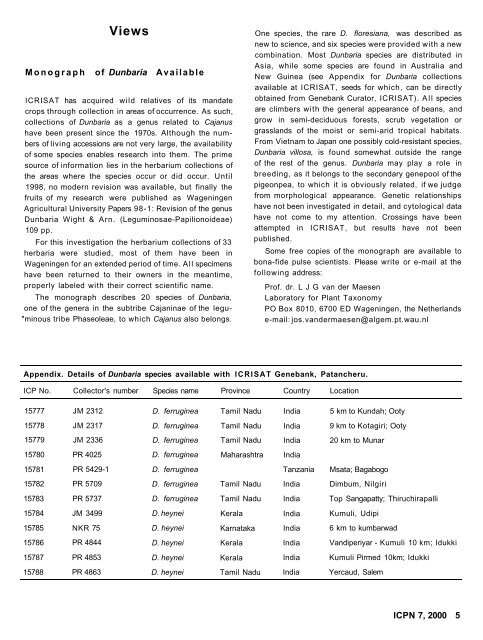Download (1227Kb) - OAR@ICRISAT
Download (1227Kb) - OAR@ICRISAT
Download (1227Kb) - OAR@ICRISAT
You also want an ePaper? Increase the reach of your titles
YUMPU automatically turns print PDFs into web optimized ePapers that Google loves.
Views<br />
Monograph of Dunbaria Available<br />
ICRISAT has acquired wild relatives of its mandate<br />
crops through collection in areas of occurrence. As such,<br />
collections of Dunbaria as a genus related to Cajanus<br />
have been present since the 1970s. Although the numbers<br />
of living accessions are not very large, the availability<br />
of some species enables research into them. The prime<br />
source of information lies in the herbarium collections of<br />
the areas where the species occur or did occur. Until<br />
1998, no modern revision was available, but finally the<br />
fruits of my research were published as Wageningen<br />
Agricultural University Papers 98-1: Revision of the genus<br />
Dunbaria Wight & Arn. (Leguminosae-Papilionoideae)<br />
109 pp.<br />
For this investigation the herbarium collections of 33<br />
herbaria were studied, most of them have been in<br />
Wageningen for an extended period of time. All specimens<br />
have been returned to their owners in the meantime,<br />
properly labeled with their correct scientific name.<br />
The monograph describes 20 species of Dunbaria,<br />
one of the genera in the subtribe Cajaninae of the legu-<br />
"minous tribe Phaseoleae, to which Cajanus also belongs.<br />
One species, the rare D. floresiana, was described as<br />
new to science, and six species were provided with a new<br />
combination. Most Dunbaria species are distributed in<br />
Asia, while some species are found in Australia and<br />
New Guinea (see Appendix for Dunbaria collections<br />
available at ICRISAT, seeds for which, can be directly<br />
obtained from Genebank Curator, ICRISAT). All species<br />
are climbers with the general appearance of beans, and<br />
grow in semi-deciduous forests, scrub vegetation or<br />
grasslands of the moist or semi-arid tropical habitats.<br />
From Vietnam to Japan one possibly cold-resistant species,<br />
Dunbaria villosa, is found somewhat outside the range<br />
of the rest of the genus. Dunbaria may play a role in<br />
breeding, as it belongs to the secondary genepool of the<br />
pigeonpea, to which it is obviously related, if we judge<br />
from morphological appearance. Genetic relationships<br />
have not been investigated in detail, and cytological data<br />
have not come to my attention. Crossings have been<br />
attempted in ICRISAT, but results have not been<br />
published.<br />
Some free copies of the monograph are available to<br />
bona-fide pulse scientists. Please write or e-mail at the<br />
following address:<br />
Prof. dr. L J G van der Maesen<br />
Laboratory for Plant Taxonomy<br />
PO Box 8010, 6700 ED Wageningen, the Netherlands<br />
e-mail: jos.vandermaesen@algem.pt.wau.nl<br />
Appendix. Details of Dunbaria species available with ICRISAT Genebank, Patancheru.<br />
ICP No.<br />
15777<br />
15778<br />
15779<br />
15780<br />
15781<br />
15782<br />
15783<br />
15784<br />
15785<br />
15786<br />
15787<br />
15788<br />
Collector's number<br />
JM 2312<br />
JM 2317<br />
JM 2336<br />
PR 4025<br />
PR 5429-1<br />
PR 5709<br />
PR 5737<br />
JM 3499<br />
NKR 75<br />
PR 4844<br />
PR 4853<br />
PR 4863<br />
Species name<br />
D. ferruginea<br />
D. ferruginea<br />
D. ferruginea<br />
D. ferruginea<br />
D. ferruginea<br />
D. ferruginea<br />
D. ferruginea<br />
D. heynei<br />
D. heynei<br />
D. heynei<br />
D. heynei<br />
D. heynei<br />
Province<br />
Tamil Nadu<br />
Tamil Nadu<br />
Tamil Nadu<br />
Maharashtra<br />
Tamil Nadu<br />
Tamil Nadu<br />
Kerala<br />
Karnataka<br />
Kerala<br />
Kerala<br />
Tamil Nadu<br />
Country<br />
India<br />
India<br />
India<br />
India<br />
Tanzania<br />
India<br />
India<br />
India<br />
India<br />
India<br />
India<br />
India<br />
Location<br />
5 km to Kundah; Ooty<br />
9 km to Kotagiri; Ooty<br />
20 km to Munar<br />
Msata; Bagabogo<br />
Dimbum, Nilgiri<br />
Top Sangapatty; Thiruchirapalli<br />
Kumuli, Udipi<br />
6 km to kumbarwad<br />
Vandiperiyar - Kumuli 10 km; Idukki<br />
Kumuli Pirmed 10km; Idukki<br />
Yercaud, Salem<br />
ICPN 7, 2000 5
















